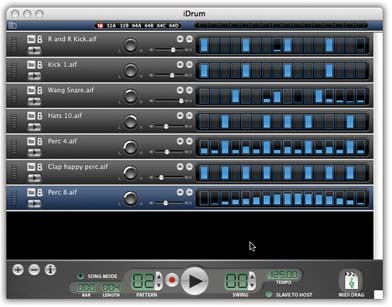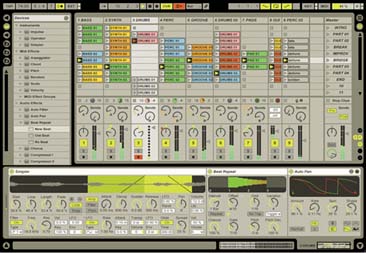9.10. Build Your Own Drum Loops (iDrum)
| < Day Day Up > |
9.10. Build Your Own Drum Loops (iDrum)Nothing defines the character of a pop song quite as much as its drum part. GarageBand comes with 280 drum loops, but relative to the universe of rock music, that's just dust in the wind. You can build your own drum parts by recording them with a MIDI keyboard, of course. But what if you're stranded on a desert island with nothing but your laptop and a power outlet (and no MIDI keyboard)? You'll need some other way to build drum loops ”like iDrum, a plug-in that installs a full-blown drum pattern editor right into GarageBand. After installing the software, you can access the iDrum screen, which works like a mini-GarageBand window, built up of parallel drum tracks (Figure 9-11). For example, you can drag these tracks up or down to rearrange them, click the + or “ buttons to delete drum tracks, adjust the L “R knob to specify each drum sound's position in the left-to-right stereo sound field, click the M button to mute a drum or S to solo it, and so on.
To build a drum pattern, position the iDrum window where you can see both it and the GarageBand window. Create a new drum track, if necessary, by clicking the + button. Choose a drum sound for this track by clicking directly on the existing drum's name (like Kick 1) and choosing from the pop-up menu. To create the drum part, drag inside each of the 16 vertical rectangles to the right of the drum header. They represent the sixteenth notes in a 4/4 measure, so to make a drum play on the first and third beats, you'd fill up the first and ninth rectangles. The height of your drag determines how loudly that drum plays on that beat. Tip: Before you spend a lot of time building a handmade pattern, try out some of the samples that come with iDrum. From the iDrum menu, choose Open. Navigate to your Home  Library Library  Application Support Application Support  iDrum iDrum  Kits folder. There, even if youre just playing with the iDrum demo version, you'll find some useful virtual drum sets to try out.The full version of iDrum ($70) comes with hundreds of ready-made drum files, each with several variations. Kits folder. There, even if youre just playing with the iDrum demo version, you'll find some useful virtual drum sets to try out.The full version of iDrum ($70) comes with hundreds of ready-made drum files, each with several variations. When the loop sounds good, you can proceed in either of two ways: leave the drum pattern as an integral part of your GarageBand project, or export it as a loop. Incidentally, iDrum isn't the only tool for building drum kits and drum loops in GarageBand. You might also want to check out DoggieBox, a less capable but easier-to-use program, or GarageBand Utilities, a set of three utilities that includes GB Drum Loops. Both of them export GarageBand-ready AIFF files that do nicely as drum loops.
You can find both of these, and many other GarageBand utilities, by searching for GarageBand at www. versiontracker .com. |
| < Day Day Up > |
- Structures, Processes and Relational Mechanisms for IT Governance
- Integration Strategies and Tactics for Information Technology Governance
- Measuring and Managing E-Business Initiatives Through the Balanced Scorecard
- Technical Issues Related to IT Governance Tactics: Product Metrics, Measurements and Process Control
- Governing Information Technology Through COBIT

